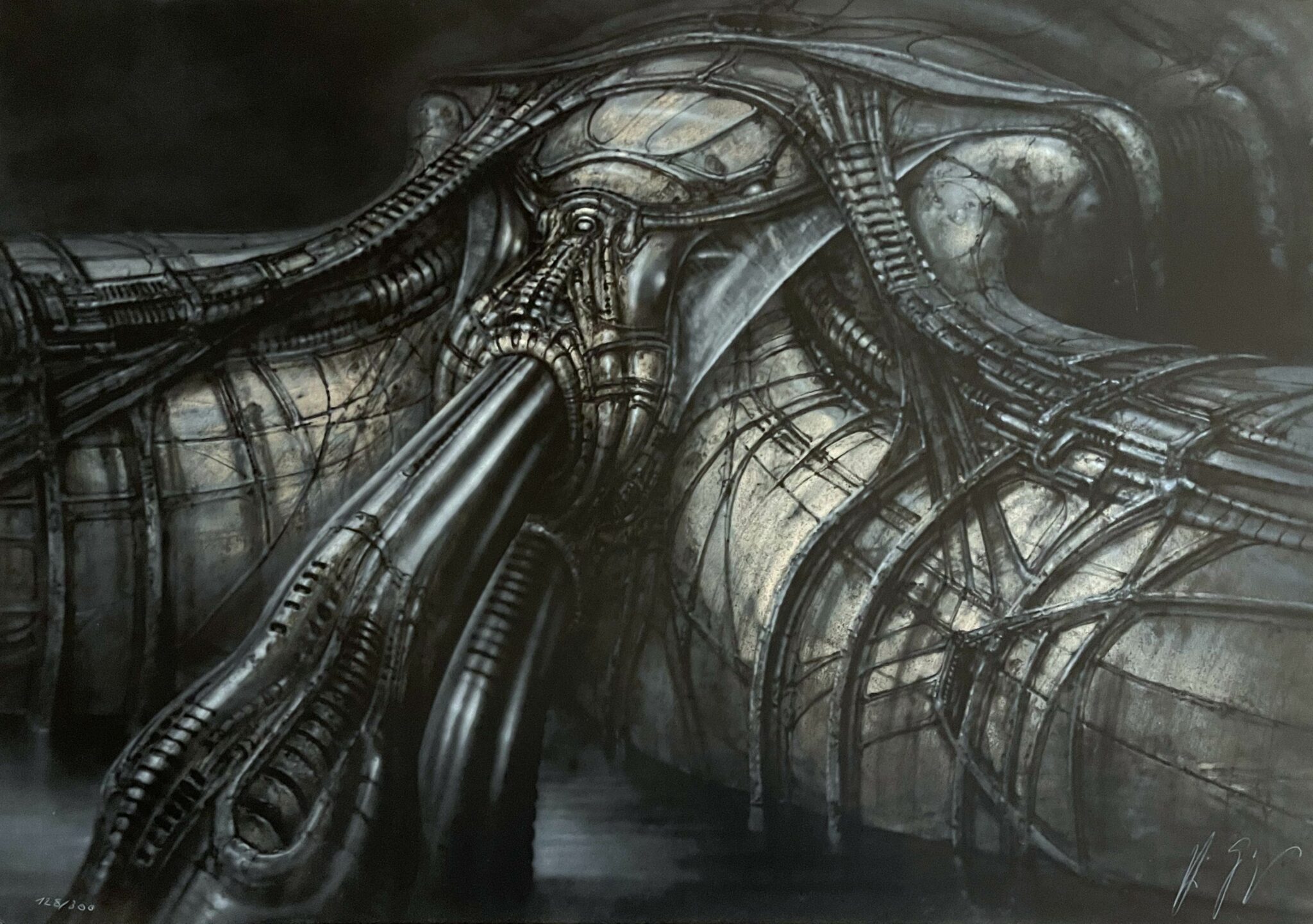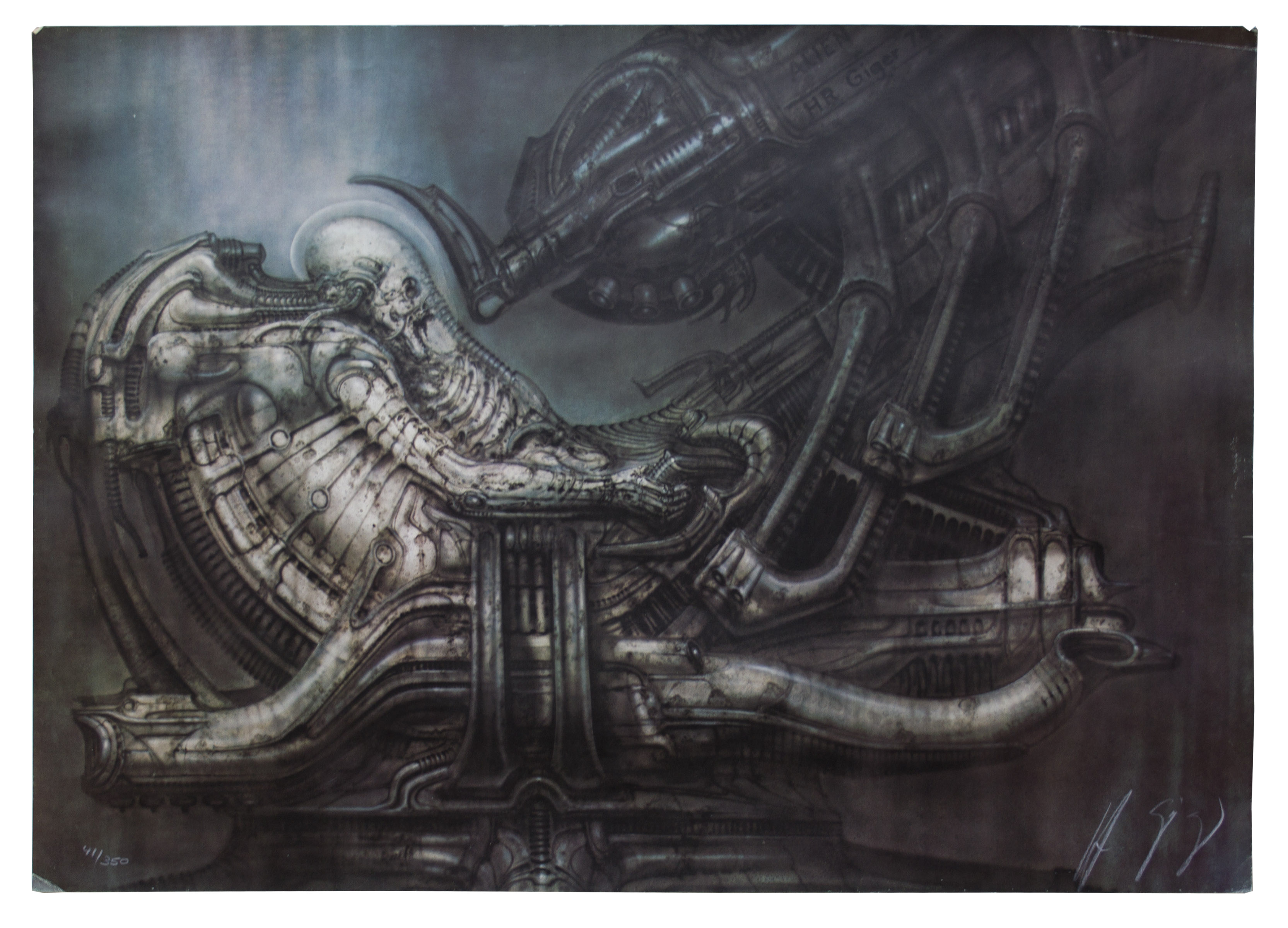Have you ever felt a chill from a piece of art, a strange pull towards something both unsettling and mesmerizing? That, too it's almost, is the very feeling many get when they encounter the distinct style of H.R. Giger artwork. This Swiss artist crafted visions that truly stick with you, known for his unique blend of the organic and the mechanical, creating a look that is really quite his own. If you're someone who appreciates art that pushes boundaries, or perhaps you're a fan of science fiction, you're likely to find Giger's creations incredibly compelling.
His work, which is rather complex and often surreal, features motifs straight out of science fiction, along with aliens and other fascinating elements. It's a style that taps into our deep fascination with what frightens us, combining horror with the grotesque in a way that is, in some respects, truly masterful. From his early days as a painter to his later designs, Giger's approach was always about pushing what art could be, making him a figure of considerable influence.
Today, H.R. Giger artwork continues to captivate audiences around the globe, maintaining a lasting position in the art and design world. Whether you're curious about the artist behind some of the most iconic science fiction visuals or just want to explore a truly original artistic mind, getting to know Giger's creations is, you know, a journey worth taking. Let's really look closer at the man and his incredible art.
Table of Contents
- Who Was H.R. Giger?
- The Biomechanical Vision: What Defines H.R. Giger Artwork?
- Beyond the Screen: H.R. Giger's Art in Film and Print
- Experiencing Giger's World: The Museum and Bar
- Finding H.R. Giger Artwork Today
- Giger's Lasting Impact
- Frequently Asked Questions About H.R. Giger Artwork
Who Was H.R. Giger?
Hans Rudolf Giger, often called Hansruedi, was a Swiss artist born in 1940. He became known as a postwar and contemporary artist, creating works that truly stood out. Giger was a painter, but his creative reach went much further, touching on sculpture and even furniture design. He was someone who, you know, really explored different ways to bring his visions to life.
Giger passed away on May 12 at the age of 74, but his artistic contributions continue to resonate. His unique perspective and ability to blend various art forms made him a truly memorable figure in the art world. He was, in a way, a master of making the unsettling beautiful.
Personal Details and Bio Data of H.R. Giger
| Full Name | Hans Rudolf Giger (Hansruedi Giger) |
| Born | 1940 |
| Died | May 12, at 74 years old |
| Nationality | Swiss |
| Known For | Surrealist works, Biomechanical art, "Alien" film design, painting, sculpture |
| Art Style | Surrealism, Biomechanical, Dark Art, Fantastic Realism |
The Biomechanical Vision: What Defines H.R. Giger Artwork?
When you talk about H.R. Giger artwork, the term "biomechanical" comes up quite a lot. This style is pretty central to his identity. It's about showing humans and machines linked together, often in a rather cold, almost symbiotic relationship. This vision is, like, incredibly distinct and instantly recognizable once you've seen it.
His early work often involved airbrush techniques, which helped him create those smooth, almost otherworldly textures. Later on, he branched out, using pastels, markers, or ink, which allowed for a different kind of expression. Regardless of the medium, the core idea of blending the organic with the artificial, the living with the manufactured, remained a constant thread in his creations.
Giger's art frequently explores themes of horror and the grotesque. He had a knack for tapping into our deepest fears, presenting them in a way that is both disturbing and strangely appealing. It's this combination of the frightening and the fascinating that makes his pieces so powerful and, you know, truly unforgettable.
Beyond the Screen: H.R. Giger's Art in Film and Print
For many people, their first encounter with H.R. Giger artwork was through Ridley Scott's 1979 film "Alien." Giger was responsible for the truly otherworldly visuals of the space monster in that movie, a design that pretty much redefined cinematic horror. That revolutionary design for the creature had a massive impact on science fiction, and it's still celebrated today.
But his contributions weren't just limited to one film. Giger's influence on the world of science fiction and pop culture is, frankly, quite significant. He shaped how we imagine alien life and terrifying creatures on screen. His design sensibility went far beyond just one character; it created an entire aesthetic that many artists and designers have drawn from since.
Beyond film, Giger also made a mark with his published works. His book "Necronomicon" is, in fact, considered the first major published collection of his images. This compendium really gives you a good sense of his artistic range and vision. Also, there's a new book called "Film Design" that is now available in an ultra-limited edition, offering another look at his creative process for cinema.
Experiencing Giger's World: The Museum and Bar
If you want to truly immerse yourself in the world of H.R. Giger artwork, a visit to the Museum HR Giger in Gruyères, Switzerland, is, you know, highly recommended. The entire third floor of this museum is dedicated to a permanent display of Giger’s own art collection. It presently consists of over 300 works, giving visitors a really comprehensive view of his creative output.
Adjacent to the museum, you'll find the fantastic Museum HR Giger Bar, which was completed in 2003. This bar is, actually, a work of art in itself, inspired by the baroque period but with Giger's distinct touch. The ceiling, walls, floors, fittings, tables, and chairs have all been modeled by the artist in his signature style. It’s a truly immersive experience, making you feel like you've stepped right into one of his paintings.
The museum and bar offer a unique opportunity to see his original creations up close. For any inquiries about H.R. Giger sculpture, limited editions, furniture, and other artwork, you can contact the HR Giger Museum directly. It’s a pretty special place for fans and art lovers alike.
Finding H.R. Giger Artwork Today
For those interested in acquiring H.R. Giger artwork, there are several avenues to explore. Artnet, for example, lists 574 of Giger’s artworks. You can also see available prints and multiples, which offer a way to own a piece of his vision. These might include works on paper, or perhaps even smaller sculptures.
Additionally, you can browse upcoming and past auction lots by H.R. Giger. This is often where you'll find more unique or rare pieces, like original paintings or drawings. It's worth noting that for any inquiries about H.R. Giger sculpture, limited editions, furniture, and artwork, contacting the HR Giger Museum is a good first step for reliable information.
When looking for H.R. Giger artwork, it’s important to be sure of authenticity. The official website, www.hrgiger.com, went online in April 1996, serving as the artist's first established online presence. The little Giger page, which is an official supplement to this website, also provides a database of his art and lists of books, film design, and other artwork. If a piece isn't linked from there or to a legitimate licensor, it is, you know, unlikely to be authentic or created by H.R. Giger himself.
Giger's Lasting Impact
H.R. Giger’s career as an alternative industrial artist has had, in fact, a truly lasting position in terms of his influence on the world of art and design. Since his revolutionary design for Ridley Scott’s "Alien," the world of science fiction and horror has never quite been the same. His unique aesthetic has inspired countless artists, filmmakers, and designers, pretty much shaping how we imagine dark, futuristic worlds.
His work showed us that art could be both beautiful and terrifying, pushing the boundaries of what was considered acceptable or even possible. Giger tapped into something primal, a fascination with the things that frighten us the most, and presented it with incredible artistic skill. This ability to combine horror with a strange elegance is, like, a hallmark of his genius.
Even after his passing, H.R. Giger artwork continues to be a subject of discussion and admiration in galleries and museums. Institutions such as the Deste Foundation and Centre for Contemporary Art have featured his creations, showing his ongoing relevance. His surreal world, with its iconic biomechanical elements, truly remains a powerful force in art and pop culture, and it’s clear his influence will continue for a very long time.
Frequently Asked Questions About H.R. Giger Artwork
What is H.R. Giger best known for?
H.R. Giger is widely recognized for his complex surrealist works, which often feature aliens and other motifs from science fiction. He is, you know, most famously known for designing the iconic space monster in Ridley Scott's 1979 film "Alien," which really brought his unique biomechanical style to a global audience.
Where can I see H.R. Giger's original art?
You can see a significant collection of H.R. Giger's original art at the Museum HR Giger in Gruyères, Switzerland. The entire third floor of the museum is dedicated to his permanent display, showcasing over 300 works. Additionally, some of his pieces are available for sale through art platforms like Artnet, and also appear in auctions.
What is the "biomechanical" style in H.R. Giger's art?
The "biomechanical" style is a core characteristic of H.R. Giger artwork. It involves depicting humans and machines linked together in a cold, often symbiotic relationship. This unique aesthetic blends organic, biological forms with mechanical elements, creating a look that is both futuristic and, you know, a bit unsettling, drawing from themes of horror and the grotesque.
To discover more about H.R. Giger's lasting impact, you might want to Learn more about H.R. Giger's creative process on our site, and also explore other influential surrealist artists.



